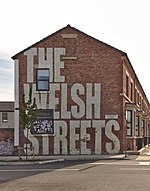Princes Road (Liverpool)
Incomplete lists from February 2011Streets in LiverpoolUse British English from August 2017

Princes Road is a street in Toxteth, Liverpool, England. It runs from a traffic circle at the northern extremity of Princes Park where Croxteth, Devonshire, and Kingsley Roads join, northwest about one kilometre to Upper Parliament Street. It is paralleled along most of its length by Princes Avenue, with a tree-lined strip between them, where there were formerly tram rails. In Liverpool's nineteenth-century heyday, Princes Road was a grand avenue of merchants' houses, some of which have since fallen into disrepair or been demolished.
Excerpt from the Wikipedia article Princes Road (Liverpool) (License: CC BY-SA 3.0, Authors, Images).Princes Road (Liverpool)
Princes Road, Liverpool Toxteth
Geographical coordinates (GPS) Address Nearby Places Show on map
Geographical coordinates (GPS)
| Latitude | Longitude |
|---|---|
| N 53.3934 ° | E -2.962 ° |
Address
Princes Road
Princes Road
L8 8JW Liverpool, Toxteth
England, United Kingdom
Open on Google Maps











